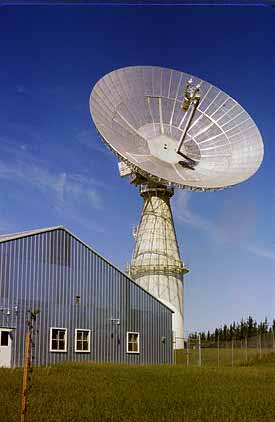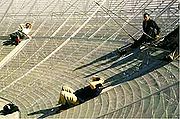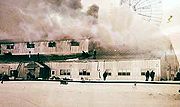
Prince Albert Radar Laboratory
Encyclopedia



Radar
Radar is an object-detection system which uses radio waves to determine the range, altitude, direction, or speed of objects. It can be used to detect aircraft, ships, spacecraft, guided missiles, motor vehicles, weather formations, and terrain. The radar dish or antenna transmits pulses of radio...
research facility operated by the Defence Research Telecommunications Establishment (DRTE), part of the Canadian Defence Research Board. Its primary purpose was to test long-range radio propagation and radar techniques in the presence of the aurora borealis. This was part of a greater ABM
Anti-ballistic missile
An anti-ballistic missile is a missile designed to counter ballistic missiles .A ballistic missile is used to deliver nuclear, chemical, biological or conventional warheads in a ballistic flight trajectory. The term "anti-ballistic missile" describes any antimissile system designed to counter...
effort being carried out in concert with the United States Air Force
United States Air Force
The United States Air Force is the aerial warfare service branch of the United States Armed Forces and one of the American uniformed services. Initially part of the United States Army, the USAF was formed as a separate branch of the military on September 18, 1947 under the National Security Act of...
, and PARL operated along with two similar instruments at the Rome Air Development Centre
Rome Laboratory
The Rome Laboratory, formerly known as the Rome Air Development Center, is one of eight research and development labs run by the US Air Force located at Griffiss AFB in Rome, NY. One of four superlabs run by the Air Force, the Rome Lab is tasked with generic research, as opposed to having a...
and MIT Lincoln Laboratory. The site continues to operate today, used as a satellite downlink station known as the Prince Albert Satellite Station (PASS).
The original study that led to PARL came about as the side effect of questions about the effects of the aurora on radar systems. There was some concern that the aurora could shield incoming reentry vehicles from observation until they were too low to be effectively attacked by the long range interceptor missiles then being designed (Nike Zeus). The United States Air Force
United States Air Force
The United States Air Force is the aerial warfare service branch of the United States Armed Forces and one of the American uniformed services. Initially part of the United States Army, the USAF was formed as a separate branch of the military on September 18, 1947 under the National Security Act of...
sent a request to Peter Forsyth for further information. Forsyth had done extensive research on the aurora while earning his PhD at the University of Saskatchewan
University of Saskatchewan
The University of Saskatchewan is a Canadian public research university, founded in 1907, and located on the east side of the South Saskatchewan River in Saskatoon, Saskatchewan, Canada. An "Act to establish and incorporate a University for the Province of Saskatchewan" was passed by the...
, Saskatoon
Saskatoon
Saskatoon is a city in central Saskatchewan, Canada, on the South Saskatchewan River. Residents of the city of Saskatoon are called Saskatonians. The city is surrounded by the Rural Municipality of Corman Park No. 344....
, including the first observations using radar.
Forsyth was invited to a meeting at Rome, the outcome eventually led to an agreement whereby two radars would be sent to Canada, one would be placed in Fort Churchill
Fort Churchill (rocket launch site)
Fort Churchill is a rocket launching complex located in Churchill, Manitoba. The site has been used on and off since the mid-1950s for sub-orbital launches of various sounding rockets during several major studies...
, where the aurora is often at its maximum, while another would be located a distance away at a lower "grazing angle" in order to compare the returns from two different locations. Finding a suitable location was not difficult; they wanted a site near Saskatoon so travel from the University would not be onerous, but one that would have line-of-sight visibility of Churchill. At first a site outside Dundurn was considered, but eventually Prince Albert
Prince Albert, Saskatchewan
Prince Albert is the third-largest city in Saskatchewan, Canada. It is situated in the centre of the province on the banks of the North Saskatchewan River. The city is known as the "Gateway to the North" because it is the last major centre along the route to the resources of northern Saskatchewan...
was selected instead. This may have had a lot to do with Prince Albert being in the home riding of the Prime Minister, John Diefenbaker
John Diefenbaker
John George Diefenbaker, PC, CH, QC was the 13th Prime Minister of Canada, serving from June 21, 1957, to April 22, 1963...
.
After a visit to Millstone Hill Observatory
Millstone Hill Observatory
Millstone Hill Observatory is a Massachusetts Institute of Technology atmospheric sciences research centre in Westford, Massachusetts.- External links :* http://www.haystack.edu/atm/mho/index.html...
, where the Lincoln Lab was developing what would become the BMEWS radar, a suitable lab for the Prince Albert site was selected. The Millstone Hill site used a prefab steel building, but a Canadian equivalent was selected in its place, and construction on the "silo" for the radar started while the buildings arrived and were assembled.
The BMEWS radar operated on a frequency of 448 MHz with a peak design power of 2.5 MW and maximum average power of 100 kW. The output was fed via waveguide to an 84 foot parabolic reflector mounted on an altazimuth mount
Altazimuth mount
An altazimuth or alt-azimuth mount is a simple two-axis mount for supporting and rotating an instrument about two mutually perpendicular axes; one vertical and the other horizontal. Rotation about the vertical axis varies the azimuth of the pointing direction of the instrument...
. It was equipped with a conical scanning
Conical scanning
Conical scanning is a system used in early radar units to improve their accuracy, as well as making it easier to steer the antenna properly to point at a target...
feed, providing higher resolution and making automatic tracking easier.
Limited operations started in 1959. The official opening was on June 6, 1959, by John Diefenbaker. For this event, a recorded message by U.S. President Dwight D. Eisenhower
Dwight D. Eisenhower
Dwight David "Ike" Eisenhower was the 34th President of the United States, from 1953 until 1961. He was a five-star general in the United States Army...
was to be broadcast from the Millstone Hill site, reflected off the Moon
Moon
The Moon is Earth's only known natural satellite,There are a number of near-Earth asteroids including 3753 Cruithne that are co-orbital with Earth: their orbits bring them close to Earth for periods of time but then alter in the long term . These are quasi-satellites and not true moons. For more...
, and received at PARL. After some tense debugging prior to the attempt, the "trick" went off without a hitch.
The main purpose of the instrument was radar observation of the aurora, which started in January 1960 and were carried out for some time. Rockets fired from Churchill, often Black Brant
Black Brant (rocket)
The Black Brant is a Canadian-designed sounding rocket built by Bristol Aerospace in Winnipeg, Manitoba. Over 800 Black Brants of various versions have been launched since they were first produced in 1961, and the type remains one of the most popular sounding rockets ever built...
s, were tracked by PARL at angles similar to those that the BMEWS radar would be tracking over-pole missile launches from its sites in Alaska and Greenland. PARL also tracked Arcas
Arcas (rocket)
Arcas — also designated ARCAS — was the designation of an American sounding rocket, which was launched between July 31, 1959 and August 9, 1991 at least 421 times. The Arcas has a maximum flight altitude of 52 kilometers, a takeoff thrust of 1.5 kN, a takeoff weight of 34 kilograms, and a...
rockets fired from Cold Lake
Cold Lake
-Military Base:* CFB Cold Lake, also referred to as 4 Wing Cold Lake and formerly known as RCAF Station Cold Lake, is a Canadian air force base....
. In order to support this work, an experimental computer built at the DRTE in Ottawa, known only as the DRTE Computer
DRTE Computer
The DRTE Computer was a transistorized computer built at the Defence Research Telecommunications Establishment , part of the Canadian Defence Research Board. It was one of the earlier fully transistorized machines, running in prototype form in 1957, and fully developed form in 1960...
, was adapted to create the Digital Analyzer and Recorder, or DAR.
The site was also used as a space radar system, starting a satellite tracking program in February 1960. The radar was used to track the decay of several satellites, including Sputnik 3
Sputnik 3
Sputnik 3 was a Soviet satellite launched on May 15, 1958 from Baikonur cosmodrome by a modified R-7/SS-6 ICBM. It was a research satellite to explore the upper atmosphere and the near space, and carried a large array of instruments for geophysical research....
, 4
Sputnik 4
Korabl-Sputnik 1 , was the first test flight of the Soviet Vostok programme, and the first Vostok spacecraft. It was launched on May 15, 1960. Though Korabl-Sputnik 1 was unmanned, it was a precursor to the first human spaceflight, Vostok 1...
and 5
Sputnik 5
Korabl-Sputnik 2 , also known as Sputnik 5 in the West, was a Soviet artificial satellite, and the third test flight of the Vostok spacecraft. It was the first spaceflight to send animals into orbit and return them safely back to Earth...
, Delta 2, and Epsilon 2. Sputnik 4
Sputnik 4
Korabl-Sputnik 1 , was the first test flight of the Soviet Vostok programme, and the first Vostok spacecraft. It was launched on May 15, 1960. Though Korabl-Sputnik 1 was unmanned, it was a precursor to the first human spaceflight, Vostok 1...
was the first test of the Vostok spacecraft
Vostok spacecraft
The Vostok was a type of spacecraft built by the Soviet Union. The first human spaceflight in history was accomplished on this spacecraft on April 12, 1961, by Soviet cosmonaut Yuri Gagarin....
; after launch its orbital period was 91.27 minutes, but on May 19 the PARL staff noted that the period was 94.26 minutes and it had been joined by seven new objects. It is assumed this was due to an explosion. PARL also used the Echo 1
Echo satellite
Project Echo was the first passive communications satellite experiment. Each of the two American spacecraft was a metalized balloon satellite acting as a passive reflector of microwave signals. Communication signals were bounced off of them from one point on Earth to another.-Echo 1:NASA's Echo 1...
satellite in a repetition of the earlier Moon-bounce experiments.
After being operational only a short time, on January 31, 1961 a major fire broke out that destroyed the buildings. Contrary to the findings of the government, the "equivalent" building did not have nearly the same fireproofing as the US design, and the fire proved unstoppable. Some of the equipment was saved, and replacements forthcoming, and the radar was soon in operation again. DAR was one of the instruments lost in the 1961 fire, and a replacement had to be built, arriving in 1962.
PARL later served a number of roles. For some time it was the major Canadian ground receiving station for satellite communications, both for US satellites, and the Canadian Alouette 1
Alouette 1
Alouette 1 was Canada's first satellite, and the first satellite constructed by a country other than the USSR or the United States. Occasionally, Alouette 1 is misrepresented as the third satellite successfully put in orbit, rather than being from the third country to have one of its own in space,...
. The DRTE Computer was used in this role too, calculating the path of the satellite over the PARL site, allowing the radar dish to be steered into the proper location to receive the signals from the quickly moving source. In 1968 the distance from the Algonquin Radio Observatory
Algonquin Radio Observatory
The Algonquin Radio Observatory is a radio telescope research facility located in the Algonquin Provincial Park in Ontario, Canada. The site's primary instrument is a major 46 m parabolic-dish radio antenna. This instrument is historically famous for taking part in the first successful very...
to the PARL site was measured to 2,143 km +/- 20 m.
Today the Prince Albert Satellite Station is operated by Canada Centre for Remote Sensing
Canada Centre for Remote Sensing
The Canada Centre for Remote Sensing is a branch of Natural Resources Canada's Earth Science Sector. It was created in 1970 with Lawrence Morley as the first Director General...
a branch of Natural Resources Canada
Natural Resources Canada
The Department of Natural Resources , operating under the FIP applied title Natural Resources Canada , is the ministry of the government of Canada responsible for natural resources, energy, minerals and metals, forests, earth sciences, mapping and remote sensing...
as a ground station for the following satellites:
- ERSEuropean Remote-Sensing SatelliteEuropean remote sensing satellite was the European Space Agency's first Earth-observing satellite. It was launched on July 17, 1991 into a Sun-synchronous polar orbit at a height of 782–785 km.-Instruments:...
- ENVISATEnvisatEnvisat is an Earth-observing satellite. It was launched on 1 March 2002 aboard an Ariane 5 from the Guyana Space Centre in Kourou, French Guyana into a Sun synchronous polar orbit at an altitude of...
- NOAA
- Landsat
- RADARSAT-1RADARSAT-1Radarsat-1 is Canada's first commercial Earth observation satellite.-Mission:It was launched at 14h22 UTC on November 4, 1995 from Vandenberg AFB in California, into a sun-synchronous orbit above the Earth with an altitude of 798 kilometers and inclination of 98.6 degrees...
- RADARSAT-2RADARSAT-2Radarsat-2 is an Earth observation satellite that was successfully launched December 14, 2007 for the Canadian Space Agency by Starsem, using a Soyuz FG launch vehicle, from Kazakhstan's Baikonur Cosmodrome....

